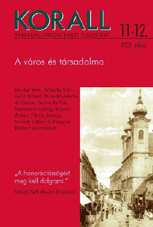Ipari város, új város, szocialista város
Industrial City, New City, Socialist City
Author(s): Pál GermuskaSubject(s): History
Published by: KORALL Társadalomtörténeti Egyesület
Keywords: social history; urban history; Hungary; 20th century; definition of cities in the socialist era
Summary/Abstract: This study seeks answer to three questions: Which criteria define the industrial, the new and the socialist city, which characteristics differentiate these from traditional, old cities, and which Hungarian towns might be called socialist ones? A survey of relevant literature has shown that contrarily to Hungary, where only slight attempts have been made to clarify terminology related to the subject, there is a variety of theoretical and empirical research going on internationally to explore cities founded after the Second World War. Based on Hungarian findings primarily, the author has set up a new definition to characterize socialist cities. The five criteria, according to which a socialist city is possible to define, are the following: a prominent position in redistributive systems; the domination of industrial functions; a majority of industrial workers among the population; the lack of urban tradition and urban centre; a dynamic growth and multiplication of the urban population. Along to these conditions, one can classify the following eleven Hungarian cities as socialist cities: Ajka, Dunaújváros, Kazincbarcika, Komló, Oroszlány, Ózd, Salgótarján, Százhalombatta, Tatabánya, Tiszaújváros and Várpalota.
Journal: Korall - Társadalomtörténeti folyóirat
- Issue Year: 2003
- Issue No: 11-12
- Page Range: 239-259
- Page Count: 21
- Language: Hungarian

